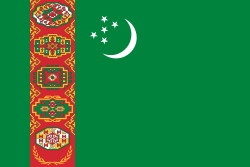Flag of Turkmenistan facts for kids
The flag of Turkmenistan is the national flag of the country Turkmenistan. It was officially adopted on January 24, 2001. Many people say it is the most detailed national flag in the world.
Contents
The Flag's Design
The flag has a green background. It features a vertical red stripe on the left side, which is called the hoist side. This red stripe contains five special carpet designs, known as guls. Below these guls are two crossed olive branches. These branches look similar to those found on the flag of the United Nations.
In the upper left corner of the green part, there is a white waxing crescent moon. Next to the moon, there are five white five-pointed stars. The crescent moon is a common symbol for Turkic cultures.
What the Colors and Symbols Mean
The colors green and red are very important in this flag. They have been respected by the Turkmen people throughout history.
The white waxing crescent moon symbolizes the country's hope for a bright and shining future. The five white stars represent the five main provinces of Turkmenistan. These provinces are Ahal, Balkan, Dashhowuz, Lebap, and Mary.
The Special Carpet Designs
The five traditional carpet designs on the red stripe are very significant. They represent the five major tribes or families of Turkmenistan. These designs are also used in the country's national emblem.
The tribes are shown in a specific order, from top to bottom. They are the Teke (Tekke), Yomut (Yomud), Arsary (Ersary), Chowdur (Choudur), and Saryk (Saryq). Some smaller tribes are not shown on the flag.
The Olive Branches
The olive branches on the flag represent Turkmenistan's "permanent neutrality." This special status was accepted by the United Nations General Assembly on December 12, 1995. It means Turkmenistan aims to stay out of conflicts and maintain peaceful relations with all countries.
Images for kids
-
2017 meeting of Vladimir Putin and Gurbanguly Berdimuhamedow; Turkmenistani flag behind them
See also
 In Spanish: Bandera de Turkmenistán para niños
In Spanish: Bandera de Turkmenistán para niños




